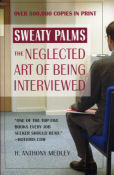| What REALLY goes on in a job interview? Find out in the new revision of "Sweaty Palms: The Neglected Art of Being Interviewed" by Tony Medley, updated for the world of the Internet . Over 500,000 copies in print and the only book on the job interview written by an experienced interviewer, one who has conducted thousands of interviews. This is the truth, not the ivory tower speculations of those who write but have no actual experience. "One of the top five books every job seeker should read," says Hotjobs.com. Click the book to order. Now also available on Kindle. | |
| Salinger (9/10) by Tony Medley Runtime 120 minutes OK for children. From my experience in trying to get to a screening for this documentary about J. D. (Jerry) Salinger, hermetic author of The Catcher in the Rye (1951), his elusiveness is alive and well. This is one I really wanted to see. When I didnít receive an invite from The Weinstein Company, I asked one of my papers to get me one. After a few days I got a call back saying that they had tried with the production company, but they, the production company, didnít know who the PR firm was (thatís so ridiculous I canít even think of a comment), so she called the Producers Guild and they struck out, too. I finally had to see this the day it opened with real people in the audience. I saw it at a 1:30 screening at The Landmark in Los Angeles and even at that time the theater was half full. I have always been fascinated by the story of Oona OíNeill, the daughter of abusive playwright, Eugene, who married 53-year-old Charlie Chaplin on her 18th birthday. I had never seen a picture of her or understood how someone that young, a debutante from a famous family (although her mother divorced her father when she was 2) could do such a thing. This film opens the book on Oona. She was gorgeous, a Gene Tierney lookalike, as shown by the pictures in this film, and led a sophisticated life, coming home from high school when she was 16 to do her homework and then change clothes and go to the Stork Club and other New York playgrounds for the rich and famous. Salinger met her and was madly in love with her. When he went in the army during WWII, she suddenly moved to Hollywood, met and married Charlie, and J.D. was a dim memory. Apparently Salinger took it extremely hard. Produced and directed by Shane Salerno, who put up the $2 million production budget himself and spent nine years on it, this is Salingerís story, told by people who knew him, like E. L. Doctorow and Gore Vidal, including his daughter and his girlfriends. He comes across as a controlling egoist who exploited very young women, writing them letters and meeting them and then establishing relationships with them. Married three times, he was so psychologically abusive to his second wife and the mother of his two children that she finally divorced him. Adding to the interest are archival pictures of Salinger while serving in Europe during World War II, including one short film clip, the only one extant, of this period of Salingerís life. For some reason there are lots of interviews and comments from A-list Hollywood types, like Philip Seymour Hoffman, Judd Apatow, Martin Sheen, Edward Norton, and John Cusack, who did not know Salinger and had no relationship to his life or story. Why they are in the film is a mystery unless they are there to attract an audience. Their comments add nothing to solving the mystery surrounding Salinger and the way he led his life. One of the interviewees paints Salinger as a master manipulator, saying of his alleged allusiveness, ďBeing out of the picture is being in the picture.Ē Also pointed out is that Salinger never had to meet with people with whom he met and who he knew would spread stories about him if he really didnít want to. Since he met with them, he obviously wanted to, so his ostensible desire for secrecy appears to be at least somewhat contrived. Particularly interesting is the story of Joyce Maynard, who became his live-in girlfriend when she was 18 and he was 53 after he contacted her about her article An Eighteen Year Old Looks Back on Life in 1972 in The New York Times Magazine. It took Salerno seven years to get her to appear and tell her story, which is fascinating. Iím not going to tell any more, but this movie is like a detective story as it tries to find out who J.D. Salinger really was and why. Even if you never read The Catcher in the Rye, this is a fascinating tale of the guy who finally wrote what many think is The Great American Novel, and which, according to convincing interviews, inspired several notorious assasins. September 6, 2013
|
|
|
|
|
